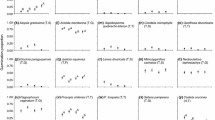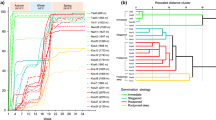Abstract
Many plants in fire-prone environments have limited dispersal ability and thus rely on in situ mechanisms such as evolutionary responses to persist through climate change. The regenerative phases of the plant life cycle, such as seed dispersal, germination and seedling establishment, are likely to be critical to defining species’ environmental niches and, in fire-prone environments, are cued to fire events. Adaptive potential in traits that regulate these processes is key to in situ persistence, yet variability in fire adaptive traits at the population level remains largely unexplored. To investigate adaptive potential, we quantified population-level variability in the thermal germination niche of a widespread fire-prone species complex, the Banksia spinulosa group. In one of the first studies of rising temperatures on germination in serotinous plants, we sampled seeds from 12 source populations spanning seven degrees of latitude and more than 1000 m of elevation and tested germinability over a range of incubation temperatures in common laboratory conditions. Thermal germination niches varied appreciably among source populations, suggesting local adaptation or other mechanisms of differentiation. Some of this variation was explained by current taxonomic boundaries, but germination responses also varied within recognised taxa and within populations. A small but significant portion of the interpopulation variation was related to thermal conditions at the source populations. As well, intrapopulation variation was greater within source populations of taxa from warm climates than those from cooler climates. The expected effect of warming is to narrow the window for germination to the cooler months of the year. The development of fire management strategies that reduce risks of post-fire mortality of seeds and seedlings, and exploit adaptive potential to promote in situ persistence as the climate changes, should therefore be a priority for climate adaptation research.




Similar content being viewed by others
References
Ashcroft MB, Gollan JR (2013) Moisture, thermal inertia, and the spatial distributions of near-surface soil and air temperatures: understanding factors that promote microrefugia. Agric For Meteorol 176:77–89
Auld TD, O’Connell MA (1991) Predicting patterns of post-fire germination in 35 Eastern Australian Fabaceae. Aust J Ecol 16:53–70
Cardillo M, Pratt R (2013) Evolution of a hotspot genus: geographic variation in speciation and extinction rates in Banksia (Proteaceae). BMC Evol Biol 13:155
Cochrane A, Hoyle GL, Yates CJ, Wood J, Nicotra AB (2014a) Predicting the impact of increasing temperatures on seed germination among populations of Western Australian Banksia (Proteaceae). Seed Sci Res 24:195–205
Cochrane A, Yates CJ, Hoyle GL, Nicotra AB (2014b) Will among-population variation in seed traits improve the chance of species persistence under climate change? Glob Ecol Biogeogr 24:12–24
Enright NJ, Fontaine JB, Bowman DMJS, Bradstock RA, Williams RJ (2015) Interval squeeze: altered fire regimes and demographic responses interact to threaten woody species persistence as climate changes. Front Ecol Environ 13:265–272
Gibson A, Bachelard EP, Hubick KT (1995) Relationship between climate and provenance variation in Eucalyptus camaldulensis Dehnh. Aust J Plant Physiol 22:453–460
Grubb P (1977) The maintenance of species richness in plant communities: the importance of the regeneration niche. Biol Rev 52:107–145
Harper JL (1977) Population biology of plants. Academic press, London
Hoffmann AA, Sgrò CM (2011) Climate change and evolutionary adaptation. Nature 470:479–485
Hudson AR, Ayre DJ, Ooi MKJ (2015) Physical dormancy in a changing climate. Seed Sci Res 25:66–81. doi:10.1017/S0960258514000403
IPCC (2007) Climate change 2007: synthesis report. Contribution of Working Groups I, II and III to the fourth assessment report of the intergovernmental panel on climate change. IPCC, Geneva
IPCC (2013) Annex I: atlas of global and regional climate projections (van Oldenborgh GJ, Collins M, Arblaster J, Christensen JH, Marotzke J, Power SB, Rummukainen M, Zhou T, eds). In: Stocker TF, Qin D, Plattner GK, Tignor M, Allen SK, Boschung J, Nauels A, Xia Y, Bex V, Midgley PM (eds) Climate Change 2013: The physical science basis. Contribution of Working Group I to the Fifth Assessment Report of the Intergovernmental Panel on Climate Change. Cambridge University Press, Cambridge
Jacobs SWL, Pickard J (1981) Plants of New South Wales: a census of the cycads, conifers and angiosperms. Royal Botanic Gardens, Sydney
Keith DA (1996) Fire-driven mechanisms of extinction in vascular plants: a review of empirical and theoretical evidence in Australian vegetation. Proc Linn Soc NSW 116:37–78
Kinlan BP, Gaines SD (2003) Propagule dispersal in marine and terrestrial environments: a community perspective. Ecology 84:2007–2020
Nicotra AB, Atkin OK, Bonser SP, Davidson AM, Finnegan EJ, Mathesius U, Poot P, Purugganan MD, Richards CL, Valladares F, van Kleunen M (2010) Plant phenotypic plasticity in a changing climate. Trends Plant Sci 15:684–692
Ooi MKJ, Auld TD, Denham AJ (2012) Projected soil temperature increase and seed dormancy response along an altitudinal gradient: implications for seed bank persistence under climate change. Plant Soil 353:289–303
Sgrò CM, Lowe AJ, Hoffmann AA (2010) Building evolutionary resilience for conserving biodiversity under climate change. Evol Appl 4:326–337
Stimpson ML, Weston PH, Telford IRH, Bruhl JJ (2012) First instalment in resolution of the Banksia spinulosa complex (Proteaceae): B. neoanglica, a new species supported by phenetic analysis, ecology and geography. PhytoKeys 14:57–80
Suppiah R, Hennessy KJ, Whetton PH, McInnes K, Macadam I, Bathols J, Ricketts J, Page CM (2007) Australian climate change projections derived from simulations performed for the IPCC 4th Assessment Report. Aust Meteorol Mag 56:131–152
Thomas CD, Cameron A, Green RE, Bakkenes M, Beaumont LJ et al (2004) Extinction risk from climate change. Nature 427:145–148
Thomas PB, Morris EC, Auld TD, Haigh AM (2010) The interaction of temperature, water availability and fire cues regulates seed germination in a fire-prone landscape. Oecologia 162:293–302
Acknowledgments
We thank Andrew Letten and Mitch Lyons for assistance with the linear models and Fig. 2, Chris Simpson for assistance with climate covariables and Mark Tozer and two anonymous reviewers for comments on the draft manuscript. This work was part of an Honours project by DAK under the supervision of PJM.
Author information
Authors and Affiliations
Corresponding author
Additional information
Michael Lawes, Ross Bradstock and David Keith.
Rights and permissions
About this article
Cite this article
Keith, D.A., Myerscough, P.J. Population variation in germination traits and its implications for responses to climate change in a fire-prone plant species complex. Plant Ecol 217, 781–788 (2016). https://doi.org/10.1007/s11258-016-0576-y
Received:
Accepted:
Published:
Issue Date:
DOI: https://doi.org/10.1007/s11258-016-0576-y




